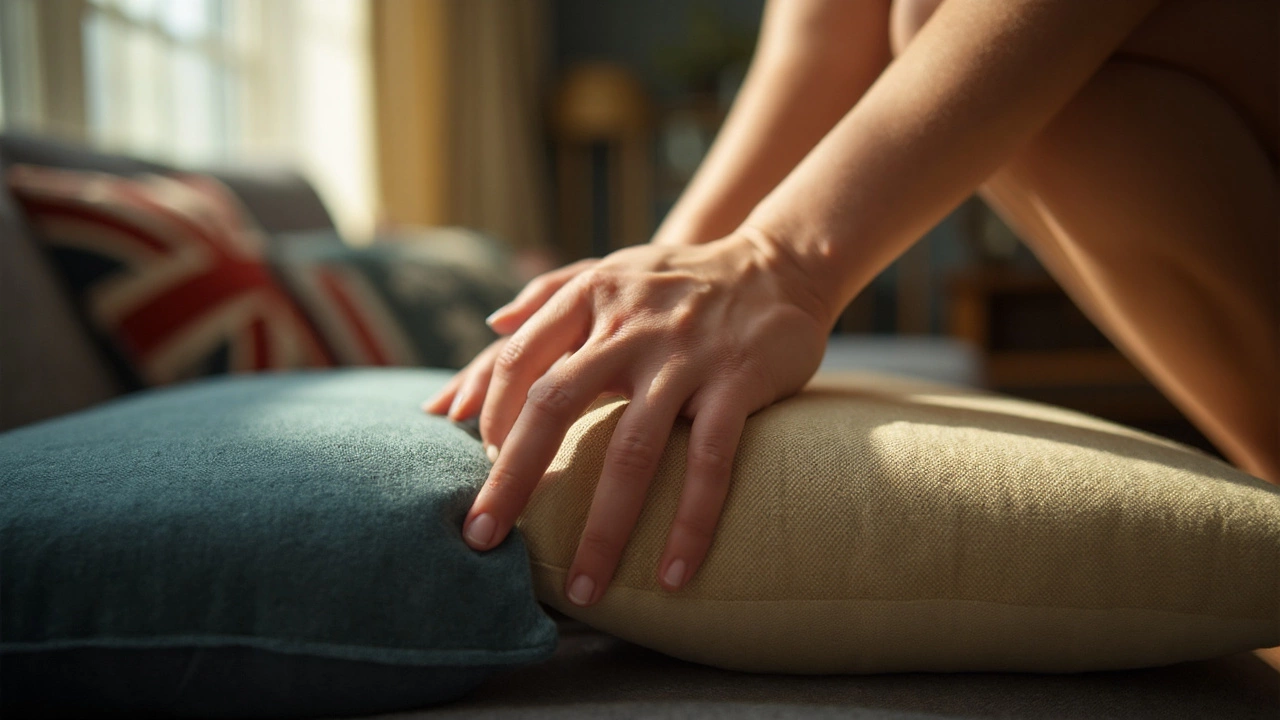You plop down after a long day, expecting that sweet cloud of comfort—but your couch hits back like a slab of plywood, or worse, swallows you up in a pit of fluff. Sound familiar? Nailing the right couch cushion thickness is kind of like nailing your favorite pair of jeans: too tight or too loose, and nothing feels right. Surprisingly, most people overlook this detail when buying a new couch or replacing old cushions, but get it wrong, and your living room will haunt your back for years. It turns out, the thickness of a couch cushion isn’t just about looks—it's about comfort, support, and even how long your furniture lasts. Let’s break down everything you never knew you needed about sofa cushion thickness, so you’re not stuck with a squishy regret (or an unforgiving perch) for the next decade.
Why the Thickness of a Couch Cushion Actually Matters
Let’s kick things off with a confession: I didn’t always think about couch cushion thickness. That changed the first time I watched my daughter, Iris, bounce from a cousin’s “fancy” new sofa like it was a trampoline—then sink halfway to the frame. What gives? Well, cushion thickness doesn’t just shape comfort, but everything from posture to how fast your sofa goes flat. There’s a real science behind that ahh-just-right feel. In practical terms, thickness acts as your first line of defense against daily sag and long-term wear. Go too thin, and every toddler leap (or Netflix binge) shortens your cushion’s life. Too thick, and you get that awkward, legs-dangling-off-the-edge effect. A good average is between four and eight inches thick, but the sweet spot depends on what you want from your sofa. Sleek, modern couches often use thinner cushions, creating that clean, tailored look, but they sacrifice plushness. Classic, overstuffed couches can go up to ten inches, but too much squish and you lose support. Not fun for your back. If your cushions hover around six to eight inches, you’re in the comfort zone for most standard couches. But that’s just the start. Your body weight, daily use, and whether you nap, lounge, or host dogs on the furniture all play roles. The material inside—foam, feather, or fiber—changes the game, too. High-density foam can do more with less—sometimes even four inches feels dreamy if the quality’s there. For the record, density and thickness are totally different; high density = firmer and longer lasting, thickness = height. Don’t confuse the two! Most major brands land between six and eight inches, for good reason. West Elm, IKEA, and Crate & Barrel all keep their cushions in this range, finding it works for the majority of people. Anything below five inches is generally only found on minimalist benches and accent chairs—not your hang-out-all-evening couch. Anything above nine inches, and you’re getting into the old-school, pillow-top-style sofas or deep modular sectionals.
Science, Comfort, and the Sweet Spot for Sofa Cushion Thickness
Now, let’s get comfy and nerdy: what actually makes a cushion feel good? It’s not just some random number on a measuring tape. Researchers at Mississippi State University did a study on the ergonomics of furniture and found that the ideal seat height for comfort is between 16 and 18 inches from the floor. Here’s why this matters—you can buy the thickest cushions in the world, but if you throw them on a low frame, you end up with knees near your chin. On the flip side, too-high cushions can make your feet dangle awkwardly. It’s all about balance. The thickness-to-density ratio plays a big part. Softer, less-dense foam needs more height to keep you from ‘bottoming out’—that’s when your weight presses all the way through and your butt meets the wood. High-density foam, usually marked as 1.8 to 2.5 pounds per cubic foot, can do better at lower thicknesses. That’s why some high-end brands offer four-inch, super-dense foam cushions with the same support as bulkier, cheaper ones. If you find yourself cushioning not just for comfort, but also for looks, you still want at least four inches—anything less and you’ll see and feel the difference in months, especially at the front edge where pressure is highest. If you’re buying online, don’t trust photos alone—brands often use staged stuffing or trick photography. Dig for those numbers! If a company doesn’t reveal thickness or density, ask. For custom jobs (which, let’s be honest, sounds more expensive than it actually is), you can mix layers: a firm, dense base for support and a thinner, plush topper for that squish factor. If you have lumbar or knee issues, don’t be shy about testing out heights—sit, stand, and repeat. Shopping with kids or pets? Go for thicker, firmer foam. Thicker cushions protect the frame too, so you won’t end up with a pricy repair in just a year or two.

How to Choose the Right Thickness for Your Sofa and Lifestyle
Here’s where things get personal—your ideal thickness isn’t just a magic number pulled from thin air. Start with how you actually use your couch. Do you sprawl out with a bowl of popcorn and a dog at your feet for hours on end? Or are you more of a percher, sipping coffee and chatting with friends? Deep couches (40 inches or more) fit best with thicker cushions; shallow sofas (under 37 inches) need thinner ones or you’ll wind up sliding off the front. Taller folks, or anyone who loves lounging, will feel at home on a deeper seat with a chunkier, eight- to ten-inch cushion. If you use your sofa for naps more than actual sleeping, a little more thickness (with plenty of support) makes all the difference. One thing people forget: how heavy are you, and what’s your household situation like? In my house, Iris treats the couch as a parkour training zone. If you’ve got kids, pets, or a big family, err on the side of thicker, firmer cushions. Not only do they bounce back better, but they shield your couch from the thud of heavy jumps and rough play. For smaller adults or those who prize a firmer ‘sit’, a thinner, denser cushion works fine. Guests who struggle to stand from low furniture? Choose thicker, firmer support to make life easier. Let’s talk about cushion fill too. Feather and down are decadent for snuggling, but they flatten quick and don’t hold shape. Synthetic fills give a puffy feel at mid-level thickness but need regular fluffing. High-resilience foam is low maintenance and lasts, but can feel stiff at first. Hybrids—foam wrapped in feathers or fiber—hit that Goldilocks zone: cushy on top, strong underneath. Living alone? You can fuss over fluffing; a full-blown family may need something you can forget about.
Common Cushion Thicknesses on the Market (With Examples)
Ready to shop? Most major retailers list their cushion specs, but if you’re not sure what the numbers mean, here’s a quick cheat sheet:
- Four-inch cushions: Used mostly on low, modern sofas and benches. Usually high-density foam. Best for occasional sitting or households where style is king and comfort isn’t.
- Six-inch cushions: The “standard” for mid-century and modern couches. Supportive enough for most people and looks tidy. You’ll see this thickness at IKEA on models like the Söderhamn, paired with medium-density foam.
- Eight-inch cushions: This is what you’ll find on most ‘classic’ and comfy sofas from Pottery Barn or West Elm. Feather-wrapped foam in this size gives you that sink-in feel, but enough structure so you don’t flop through. Also great for big families and pet owners—it handles wear better.
- Ten-inch cushions: These are rare but found in deep sectionals or old-school pillow-top sofas—think Restoration Hardware’s deep seating or modular loungers. Great for nap-nooks, but check your seat height before committing. Too high, and smaller people will feel like they need a footstool to reach the floor.

Tips for Measuring, Testing, and Maintaining Your Couch Cushion Thickness
Shopping for a new couch, or fixing up an old favorite? Measure twice, regret once. Whip out a tape measure and check your frame depth and height from floor to seat deck, not just the overall couch size. The usual rule: subtract your desired cushion thickness from the overall seat height (remember the 16-to-18-inch comfort zone) to see if you’ll be hitting that ergonomic sweet spot. Thick cushions may compress over time, so start half an inch higher than your goal to avoid low-rider syndrome down the line. Always sit before you buy—yeah, it means braving the wilds of a showroom. If you’re ordering online, look for return policies that let you test at home. When testing, plant your feet flat on the ground, scoot back, and stand up—your knees shouldn’t lock or reach up high. If they do, your cushion is probably too thick. If your rear meets the hard deck, it’s too thin, or the density’s off. Now, let’s talk care. Rotating and flipping cushions once a month helps avoid that dreaded “butt dip”—it’s real, and it’s a pain to fix after the fact. For feather and fiber cushions, fluff after every use or at least weekly. With foam, check for sagging edges and uneven wear. If you’re in love with your existing couch but hate the cushions, plenty of shops sell custom-cut foam inserts—don’t toss the whole sofa! For wild households (thanks again, Iris), thicker, removable covers are a lifesaver. They're easier to wash, and they tend to last longer. Life hack: slide a half-inch board under sagging cushions to get another year or two out before you have to replace.
So, how thick should a couch cushion be? The truth is: aim for six to eight inches if you want a balance of support, comfort, and lasting power—especially with high-density foam. Buy thinner cushions only if you’re after a strict look or have a low-profile sofa. Mix materials and personal habits into your decision; what works for your neighbor may not fit your crew. Invest in the good stuff—in cushion land, you seriously get what you pay for. Trust your body and your lifestyle to pick that *perfect* cushion, and your living room will thank you later.

